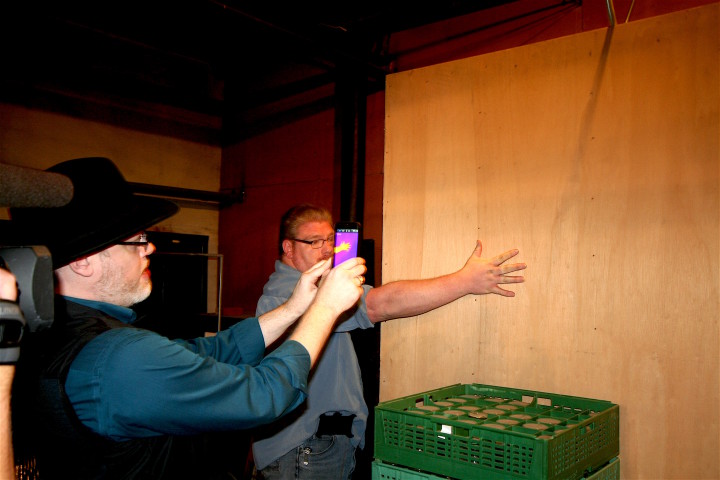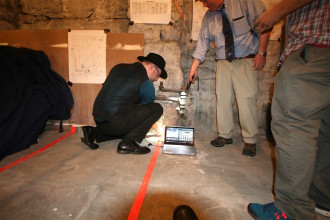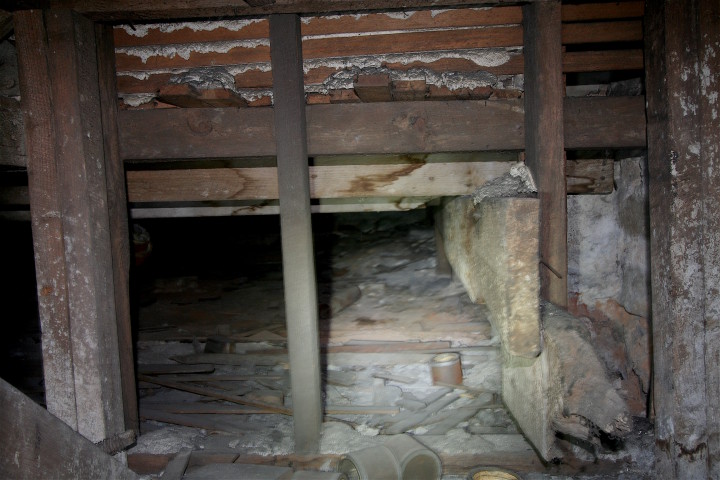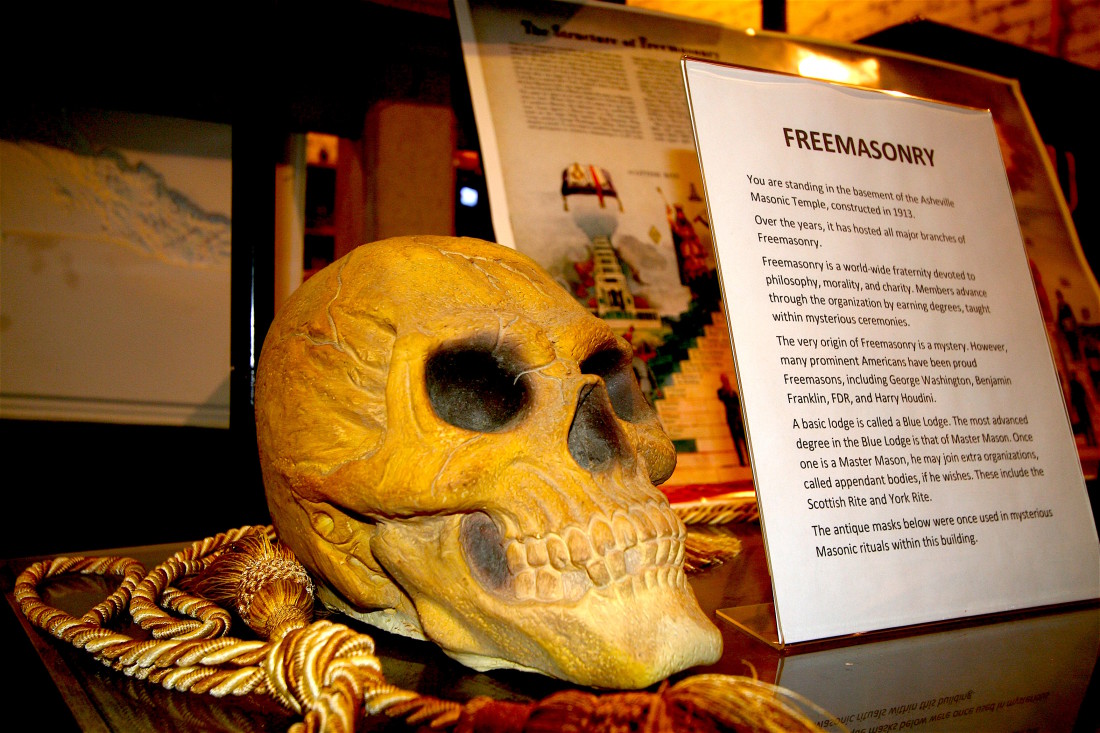Dusk gathers early on the warm evening of Oct. 24, amid the murmurs and echoing footsteps of leaf-peepers and tourists wandering through downtown Asheville. At the corner of Broadway and Woodfin Street, the brick facade of the Asheville Masonic Temple wears a tawny glow as media types and paranormal investigators gather at its side entrance to take part in local paranormal investigator Joshua P. Warren’s latest look into the city’s mysterious past.
This evening, Warren and his associates will delve into one of Asheville’s most persistent rumors: For years, stories have swirled about a clandestine tunnel network connecting the city’s historic buildings to one another. Many of these apocryphal tales place the terminus of this network squarely beneath the Masonic Temple.
Using a mix of historic research and technology, Warren’s team will attempt to find out once and for all whether the truth to these legends lies buried somewhere beneath the foundations of folklore, time and concrete.
Behind the scenes
Built in 1913 under the direction of famed architect and freemason Richard Sharp Smith, the Asheville Masonic Temple has served as a gathering place for local Masons to enact their secret rituals through much of the 20th century.
Famed for their secrecy, the freemasons have been the subject of countless rumors and conspiracy theories, says Warren, who is also a member of the Mt. Hermon Masonic Lodge. “Over the years, when people have asked if there is a tunnel connected to the Masonic Temple, we’ve always said we can neither confirm nor deny that there is one,” Warren says. “The truth is, we really don’t know. It’s possible that the masons who were here long ago kept secrets so secretive that a lot of the modern masons don’t even know about it.”

While present-day masons may get a bit of fun out of the mystery that envelops their organizations, the origins of the group’s secret handshakes and signs are more pragmatic than one might suppose. “Most of the so-called secrets of Masonry are secret for the same reason that you keep your pincode secret at the ATM,” Warren explains. “These are ways to identify each other that originated at a time before driver’s licenses and fingerprinting.”
In medieval times, freemasons used their secret codes to prove their identity while crossing through rival kingdoms for work. As international travel was much more hazardous than today, masons needed a way to prove who they were to suspicious border guards. “Those guards knew the signs and stuff, so it was invented as a way of identification,” Warren reveals.
Spiritibus in nobis
If the masons’ clandestine practices aren’t enough to imbue the Masonic Temple with a spooky aura, the building’s use as an emergency hospital for Asheville’s African-American community during the Spanish flu epidemic of 1918 adds a further touch of the macabre to the property.
“No one would take care of these poor people,” says Christian MacLeod, the vice president of the Asheville Masonic Temple Board of Directors, “so the freemasons at that time said, ‘Have the whole building.’”
Several Asheville Citizen articles from 1918 support that claim: A report from October announced that five “colored patients” had been admitted into the Masonic Temple for treatment, while a later article notes that at least nine patients were housed there during the outbreak.
“We don’t know exactly where they were kept, or what their fate was, but that’s not just a legend,” says Warren.
Things that go bump in the night
Today, the Masonic Temple serves primarily as a special events venue for Shay Brown Events, which hosts weddings and ceremonies, in addition to housing Warren’s museum of local lore and curios in the basement. But several eyewitness accounts suggest that the building’s past patrons may linger within the building’s sturdy walls.
Lewis Pratt, a Black Mountain-based paranormal investigator, claims to have seen a full-bodied apparition several years ago while working in the basement after an event. “I was headed toward the boiler room when I heard what sounded like someone dropping their keys,” Pratt recalls. “I turned around and saw a man in a black suit coming down the stairs. He was looking in his hands, like he was looking at his keys or whatever he dropped, and he walked through an archway [into another room].”
Wondering who the mysterious interloper could be, Pratt followed closely behind, only to find the adjoining room completely deserted. “I couldn’t have been more than a half-second behind him,” he says. “It was a pretty impressive apparition; it was just like a person walking through. He was an older guy. He had his head down and looked entirely natural.”
Despite the shock such ghostly sightings may inspire, MacLeod doesn’t believe any of the haints in the Temple mean harm. “I don’t know if the term ‘happy death’ is actually an oxymoron, but if there is some type of energy here, it’s probably friendly or positive, because there was that act of kindness that they couldn’t get anywhere else,” he muses.

Tunnel vision
The existence of a tunnel network beneath the city streets — alternately said to connect City Hall, the Masonic Temple, the Police Station and other historic downtown buildings, depending on the source — is one of Asheville’s most persistent rumors.
Some of the supposed tunnels have a fairly innocuous backstory: “There is a city plan in print from 1922, in which they talked about also building a subway system underneath the city,” Warren notes. While some underground infrastructure was put in place — the defunct underground bathrooms beneath the Vance Monument are one example — the stock market crash of 1929 forced city planners to abandon such dreams.
Other enterprising citizens of the time, however, saw subterranean passages as a way to conduct illicit business away from the prying eyes of the public. “There was a lot of bootlegging in Asheville,” notes Warren. “That’s why so many of the tunnels went officially undocumented.”
One such tunnel is reputed to have connected local businessman John O’Donnell’s Eureka Saloon (the present-day site of the Calypso restaurant) to a hotel across Lexington Street during Prohibition. (See “Appalachian moonshining in the 21st century,” June 23, 2015, Xpress)

“We have been in a number of these tunnels,” Warren adds. “Whether or not there is a giant structure that once connected everything…. there probably was more of a connection at one point in time, but now, we just have bits and pieces.”
History seems to have obscured any definitive evidence of a Masonic Temple tunnel, due to declining membership and sporadic usage of the building during the 1990s and early 2000s. “There’s not a whole lot of information,” concedes MacLeod. What stories he has come across, though, all say the same thing: “They went in the tunnel, came out in the basement of the lodge,” he notes. “They open up two big steel doors, climb up a set of stairs, and the second they’re out of the stairs, they have to turn left or right because they run into the side of the wall.”
These queries into the past, says Warren, have led his team to a spot in the building’s basement, which was originally a bowling alley. “If you walk around, you can see how incredibly uneven this floor is,” Warren says, pointing to an oddly raised area of the concrete basement floor. “That doesn’t make a lot of sense. We’re going to see once and for all if there really may be a tunnel here.”
Hot and cold
After a brief overview of the evening’s investigation, Warren and company go to work with a host of electronic doodads meant to detect changes in temperature, electromagnetic currents and even radiation levels.
“We’re going to look for any kind of anomaly that might be associated with a difference in air temperature below or through the walls,” Warren says. “If there is some kind of a tunnel that is connected to the walls or to the floor, we could presume that we are going to see some kind of difference in air temperature. That’ll be our first indication that there may be a tunnel that is sealed off or can be opened some way we don’t yet know about.”
The investigation begins with a “snake cam” — a long, black cable with a camera attached to the end, perfect for getting a visual feed on hard-to-reach crevices and cracks. MacLeod and Warren carefully lower the camera into an ominous-looking hole in the basement floor adjacent to the suspected tunnel site.
As the camera winds beneath the floor, an empty space of indiscernible volume is caught on-screen. Warren’s team follows up with a round of thermal testing of the area in question. Real time temperature readings around suspected tunnel entrance reveal subtle temperature fluctuations.

“See how it’s pulsating?” Warren asks, pointing to the image transmitted from his thermal camera to the screen of his phone. “There’s not a vast temperature difference, but there is a difference, given that pulsation. While the lead is promising, when paired with the snake-cam footage, Warren says that subsequent tests must be conducted to get a more accurate temperature analysis. “We have to find a time when there’s enough difference between indoor and outdoor temperature,” Warren says.
Hole in the wall
Warren and MacLeod then lead investigators and media members into an adjacent hallway, where a long staircase ascends from the basement to the main floor of the Masonic Temple. A small grate beneath the staircase, hardly large enough for a child to fit through, has been opened for the purposes of this investigation tonight.
“This probably hasn’t been opened in 75 years,” Warren proclaims, as attendees take turns peering into the disused space. With the snake cam and thermal readers, Warren and his companions collect data and search the long-forgotten crawlspace for any clues that might indicate the existence of a tunnel in the vicinity.
A gaze inside reveals little besides a century’s worth of dust and several empty varnish cans that appear to predate anyone standing in the room. While flashlights probe the interiors of the crawlspace, the investigators are left with more questions than answers.
“Look at the height of the floor, compared to the height of the floor in the basement: there’s a variation there, and I don’t know why, because there shouldn’t be,” Warren says. “This should all be level, and it’s not.”
While the group finds few clues as to the crawl space’s intended purpose, false starts are simply part of the job for paranormal investigators, notes Pratt. “Nothing says paranormal investigation like finding a dirty hole and sticking your head inside to see what’s in there,” he jokes.

Further explorations
After another round of testing in the basement, Warren convenes those in attendance to discuss the evening’s findings. “If there is a tunnel connected to this building, it seems like this may be our best candidate as the spot,” he says, indicating the original area in question.
MacLeod says he plans to present the evidence gathered to the Masonic Board at its November meeting, when he and Warren will raise the idea of probing further into the mysterious space below the basement.
“It’s definitely going to be an interesting meeting this month,” he says. “The readings don’t lie; there’s something very tangible. We’ve got witnesses that’ve seen things; there’s the history of the building. … It’s pretty much going to be a to-be-continued for right now, but I have a good feeling about it.”
Moving forward, Warren hopes members of the community with intimate knowledge of the temple’s history will step forward to provide more clues. “If there is some old mason out there who has all the secrets to the tunnels connected to this building, we would love to hear from that person, or any of his relatives that may know about it,” Warren says. “I’m easy to find on the internet.”
Regardless of what comes of the tunnel foray, MacLeod says that events like the investigation not only make for a spooky Halloween story, but shed an important light on the Masonic Temple’s past and the important role that local freemasons played in the community.
“People need to know that we’re not just a bunch of weird old white guys,” MacLeod says. “This building has been here a long time, and we try to do as much as we can for the community.”
As for what lurks beneath the basement floors of the grand historic structure of his forebears? “It could be anything,” MacLeod says with a wry smile. “It is a Masonic temple …”
Interested in finding out more about Asheville’s haunted history? Visit hauntedasheville.com or facebook.com/mysterymuseum.





Before you comment
The comments section is here to provide a platform for civil dialogue on the issues we face together as a local community. Xpress is committed to offering this platform for all voices, but when the tone of the discussion gets nasty or strays off topic, we believe many people choose not to participate. Xpress editors are determined to moderate comments to ensure a constructive interchange is maintained. All comments judged not to be in keeping with the spirit of civil discourse will be removed and repeat violators will be banned. See here for our terms of service. Thank you for being part of this effort to promote respectful discussion.